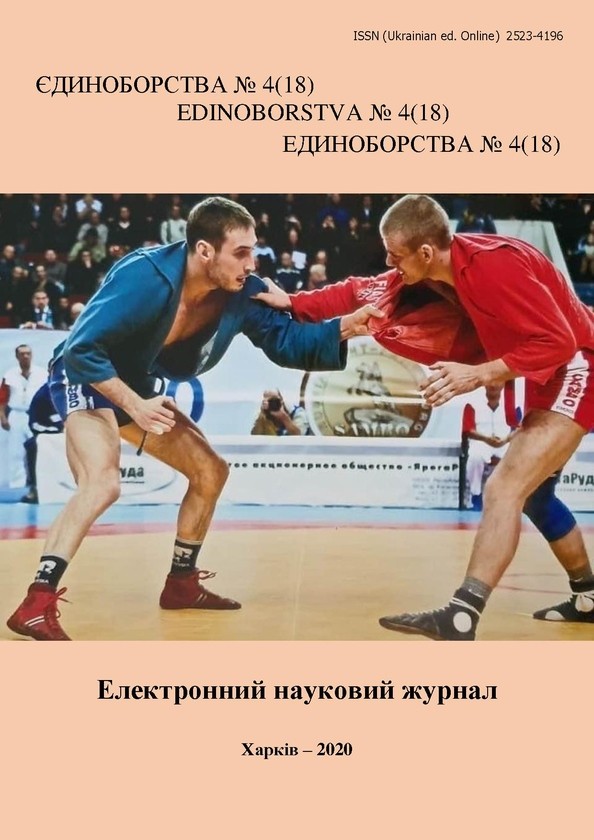Аналіз результатів виступів країн-учасниць на змаганнях з дзюдо серії Grand Slam та Grand Prix протягом 2019 року
DOI:
https://doi.org/10.15391/ed.2020-4.07Ключові слова:
дзюдо, змагання, медальний залік, рейтинг, Grand Slam, Grand PrixАнотація
Мета: здійснити аналіз результатів виступів країн-учасниць на змаганнях з дзюдо серії Grand Slam та Grand Prix протягом 2019 року. Матеріал і методи. У дослідженні використовувалися наступні методи: аналіз науково-методичної літератури, інформації в джерелах Інтернету; узагальнення передового практичного досвіду; аналіз офіційних протоколів змагань; методи математичної статистики. Проаналізовано результати виступів країн-учасниць на змаганнях серії Grand Slam та Grand Prix протягом 2019 року. Вихідні дані виступів взяті з офіційного сайту міжнародної федерації дзюдо «International Judo Federation» (IJF.org). Результати: за 2019 рік було проведено 7 старів Grand Slam та 9 стартів Grand Prix. Виявлено, що середня кількість країн-учасниць Grand Slam - 75,86, Grand Prix - 63,88. Середня кількість учасників Grand Slam - 472,2 (чоловіки - 275,0; жінки - 197,2), Grand Prix - 414,2 (чоловіки - 240,0; жінки - 174,2). Результати медального заліку країн-учасниць на змаганнях Grand Slam, Grand Prix 2019 року показали, що лідерами змагань є такі країни як Японія, Франція, Бразилія, Росія. Явним лідером являється Японія, яка зайняла призові місця у 9 стартах (Grand Slam – 5 стартів, Grand Prix – 4 старти). В серії змагань Grand Slam Японія має в своєму арсеналі 72 медалі: 29 золотих, 16 срібних та 27 бронзових. На Grand Prix здобуто 31 медаль: 19 золотих, 10 срібних та 2 бронзові. Аналіз медального заліку по ваговим категоріям показав, що Японія має спортсменів, які є лідерами у своїх категоріях (чоловіки - +100 кг; жінки - 48 кг, 57 кг, 63 кг, 70 кг, 78 кг), а в деяких категоріях таких представників декілька (чоловіки - 60 кг, 66 кг, 73 кг; жінки - 52 кг, +78 кг). Два спортсмени Nagayama Ryuju (60 кг), Hashimoto Soichi (73 кг) є лідерами не тільки в вагових категоріях, але і у світовому рейтингу серед чоловіків. Висновки. Встановлено, що на змаганнях серії Grand Slam (472,2 учасників) приймає участь більша кількість спортсменів ніж на Grand Prix (414,2 учасників). Це можна пояснити можливістю спортсмена отримати більше рейтингових балів на стартах Grand Slam. Підтверджено дані, що явним лідером світового національного рейтингу країн є Японія, яка зайняла призові місця у 5 стартах Grand Slam (72 медалі) та 4-х Grand Prix (31 медаль). Виявлено, що представники Японії стабільно отримують призові місця та мають спортсменів, які є лідерами у своїх категоріях та світовому рейтингу.
Посилання
Белый, К. В. (2020). Командный зачет на соревнованиях по единоборствам. Учетные записки университета имени П.Ф.Лесгафта, №2(180), 28-36.
Бойченко, Н. В., Чертов, І. І., Пирог, Ю. А., & Алексєєв, А. Ф. (2020). Аналіз показників змагальної діяльності висококваліфікованих дзюдоїсток легких вагових категорій. Єдиноборства, 4-12.
Жевнерова, Ж. В. (2019). Хронологический анализ медальных зачетов всемирных универсиад с 2001 года по 2019 год. Стратегия формирования здорового образа жизни населения средствами физической культуры и спорта: тенденции, традиции и, 304.
Латишев, М. В., Квасниця, О. М., Спесивих, О. О., & Квасниця, І. М. (2019). Прогнозування: методи, критерії та спортивний результат. Спортивний вісник Придніпров’я, 1, 39-47.
Латышев, Н. В., Латишев, С. В., & Шандригось, В. И (2014). Направления и виды анализа соревновательной деятельности в спортивной борьбе. Вісник Чернігівського національного педагогічного університету імені Т. Г. Шевченка, 4, 98–101.
Палатний, А. Л. (2017a). Досягнення спортсменів України у змаганнях зі спортивних єдиноборств на Іграх Олімпіад (1992–2016 рр.). Фізична активність, здоров’я і спорт, (2 (28)), 3-12.
Палатний, А. Л. (2017b). Розподіл нагород зі спортивних єдиноборств у програмах ігор олімпіад (гендерний аспект). Науковий часопис [Національного педагогічного університету імені МП Драгоманова]. Серія 15: Науково-педагогічні проблеми фізичної культури (фізична культура і спорт), (8), 48-52.
Таймазов, А. Б., & Тараканов, Б. И. (2016). Анализ результатов выступлений стран-участниц по спортивной борьбе на ХХХI Олимпийских играх. Учетные записки университета имени П.Ф.Лесгафта, №10(140), 175-180.
Тропин, Ю. Н., Латышев, Н. В., Рыбак, Л. А., & Бугаев, М. Л. (2020). Сравнительный анализ результатов выступлений национальной сборной команды Украины по спортивной борьбе. Единоборства, 3(17), 79-91.
Шандригось, В. І. (2018). Аналіз результатів борців різних країн на чемпіонаті світу з вільної боротьби серед чоловіків до 23 років. Єдиноборства, 3(9), 86-96.
Шинкарук, О. А. (2013). Теорія і методика підготовки спортсменів: управління, контроль, відбір, моделювання та прогнозування в олімпійському спорті. Навчальний посібник, Київ. 136 с.
European Judo Union [Internet]. eju.net [cited 22 july 2020]. Available from: https://attachments.eju.net/IJF%20Senior%20World%20Ranking%20List.pdf
International Judo Federation [Internet]. IJF.org [cited 22 july 2020]. Available from: https://www.ijf.org/calendar?year=2019&age=world_tour&type=all
Latyshev, M., Shandrygos, V., & Mozolyk, O. (2016). Analysis of participations and forecast for future competitions freestyle wrestling team of Ukraine. Young sport science of Ukraine, 1, 102-107.













